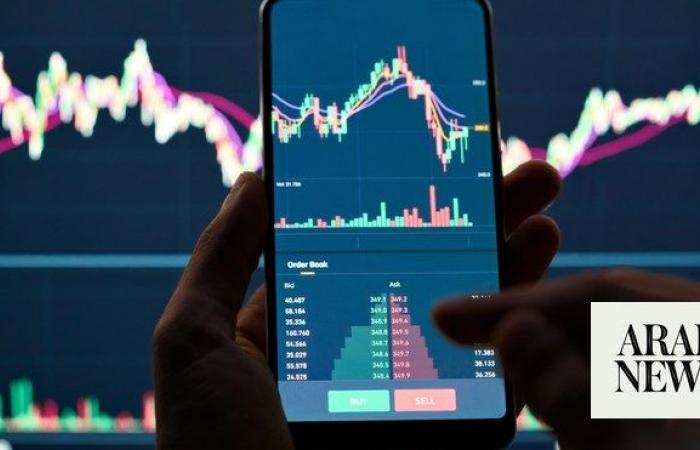Thank you for reading the news about Closing bell: Saudi main index slips to close at 12,555 and now with the details
Jeddah - Yasmine El Tohamy - RIYADH: Saudi Arabia’s money supply surged 10 percent in January to reach SR2.72 trillion ($726 billion), the central bank data showed.
The growth was primarily driven by a substantial rise in banks’ term and savings accounts, which recorded a rise of 31 percent to reach SR864.32 billion. The overall figure, however, also includes currency outside banks, demand deposits, and other quasi-money deposits.
Since the Saudi riyal is pegged to the US dollar, the rise in interest rates is also seen as a source of motivation for depositors who want to pursue more profitable avenues particularly term deposits known for their higher-yielding nature.
Fitch Ratings also noted that the liquidity boost in Saudi Arabia could be linked to a significant rise in funds from government-related entities.
According to the agency, the rise in these GRE accounts suggests that these entities chose to invest their surplus liquidity in higher income-generating deposits with commercial banks, rather than with the Saudi Central Bank, also known as SAMA.
It highlighted that these deposits serve as an expensive source of funding for banks, which has significantly increased the average cost of funding due to heightened competition in the financial market.
Reflecting on the changes, demand deposits, which constituted a 53 percent share of the money supply a year ago, now stand at 48.42 percent, with a growth rate of only 1 percent during this period.
Despite the elevated cost of funding for Saudi banks, the increase in interest rates also bolstered profits on their asset side, as higher borrowing rates resulted in greater income.
Based on data from Bloomberg compiled by Arab News, the net income of listed Saudi banks surged by 12 percent annually in 2023, reaching SR69.96 billion.
Among these, the Saudi National Bank held the largest share at 29 percent, equivalent to SR20 billion. Notably, the most significant growth in net income was observed in Saudi Awwal Bank, with profits soaring by 45 percent to reach SR7 billion.
During 2022, SAMA increased key policy rates seven times followed by an additional four times in 2023. In its July 2023 meeting, the central bank last raised its repo rate by 25 basis points to 6 percent, reaching its highest level since 2001. This move was in line with the measures taken by the US Federal Reserve as part of its efforts to combat inflation.
Saudi Arabia has nevertheless demonstrated exceptional resilience and stability in managing inflation. This success can be attributed to the steadfast implementation of robust government policies designed to safeguard the economy.
Central to this stability is the Saudi Consumer Protection Association, a vigilant guardian of fair pricing practices for essential goods and services. The Kingdom’s strong regulatory framework ensures that consumers are shielded from unwarranted price escalations, fostering an environment conducive to business.
Furthermore, Saudi Arabia’s commitment to social welfare is evident in its comprehensive policies. The Kingdom has strategically invested in initiatives such as subsidies on essential goods, affordable housing schemes, quality education programs, and accessible healthcare services.
A prime example of this commitment is the Citizen Account Program, a cornerstone of support for low- and mid-income families. Through this program, the government provides crucial cash transfers, alleviating the financial strains caused by the rising cost of living.
In January, Saudi Arabia maintained stable inflation at 1.6 percent, holding steady from December 2023, as reported by the General Authority of Statistics.
The primary driver of the inflation rate was the cost of rent, given their significant weight of 21 percent in the Saudi consumer basket.
Nevertheless, according to data from Trading Economics, the Kingdom ranked the second-lowest among G20 countries in terms of inflation, following Switzerland, which recorded a rate of 1.3 percent.
Looking ahead, Fitch Ratings anticipates that the cost of funding will continue to be sensitive to shifts in the Fed rate. However, the agency expects the average net interest margin, a crucial measure of banks’ core profitability, to stay at approximately 3 percent.
Fitch also projects a 10 percent growth in deposits for 2024, driven primarily by term accounts. The proportion of demand deposits will likely decrease, falling below 50 percent of total deposits.
The agency’s predicted Saudi banking sector financing growth stood at 10 percent in 2024, well above the Gulf Cooperation Council average of 5 percent but down from an estimated 12 percent in 2023 and 14 percent in 2022.
These were the details of the news Closing bell: Saudi main index slips to close at 12,555 for this day. We hope that we have succeeded by giving you the full details and information. To follow all our news, you can subscribe to the alerts system or to one of our different systems to provide you with all that is new.
It is also worth noting that the original news has been published and is available at Arab News and the editorial team at AlKhaleej Today has confirmed it and it has been modified, and it may have been completely transferred or quoted from it and you can read and follow this news from its main source.

